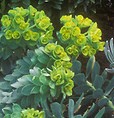 Also called donkey tail, this succulent perennial is native to southeastern Europe and Asia Minor where it is found in grassy and rocky areas. It is a member of the spurge family, Euphorbiaceae, that also includes poinsetta, cassava, and caster-oil plant. The trailing stems are eight to ten inches long and are covered with spirally arranged waxy blue-green leaves one inch in length. Chartreuse “flowers” two to four inches across are produced at the tips of the stems in spring and consist of bracts that surround an umbel of five to ten true flowers that are inconspicuous and greenish in color. A good choice for rock gardens , a wall, or front of the border. Plants are evergreen but often look ratty during the winter in cold climates and tend to be short lived in warm climates. When broken the stems exude a milky sap that can irritate the skin. At high elevations of the intermountain West myrtle spurge can be invasive. The generic name, Euphorbia, honors Euphorbus, the physician of the King of Mauretania. The specific epithet, myrsinitis, refers to the possible similarity of the plants to plants in the genus Myrsine, that is the Greek word for myrtle.
Also called donkey tail, this succulent perennial is native to southeastern Europe and Asia Minor where it is found in grassy and rocky areas. It is a member of the spurge family, Euphorbiaceae, that also includes poinsetta, cassava, and caster-oil plant. The trailing stems are eight to ten inches long and are covered with spirally arranged waxy blue-green leaves one inch in length. Chartreuse “flowers” two to four inches across are produced at the tips of the stems in spring and consist of bracts that surround an umbel of five to ten true flowers that are inconspicuous and greenish in color. A good choice for rock gardens , a wall, or front of the border. Plants are evergreen but often look ratty during the winter in cold climates and tend to be short lived in warm climates. When broken the stems exude a milky sap that can irritate the skin. At high elevations of the intermountain West myrtle spurge can be invasive. The generic name, Euphorbia, honors Euphorbus, the physician of the King of Mauretania. The specific epithet, myrsinitis, refers to the possible similarity of the plants to plants in the genus Myrsine, that is the Greek word for myrtle.
Type: Succulent perennial
Bloom: Inconspicuous greenish flowers surrounded by chartreuse bracts two to four inches across, in spring
Size: 6-9” H x 12” W
Light: Full sun
Soil: Average, dry, well-drained
Hardiness: Zones 4-9
Care: Provide winter protection in areas that have prolonged cold and lack snow cover.
Pests and Diseases: None of significance
Propagation: Tip cuttings, division; self seeds
Companion Plants: Purple Heart (Tradescantia pallida) ‘Purpurea’, pinks (Dianthus spp), creeping phlox (Phlox sublata, P. bifida), rock cress (Arabis spp.), sedums